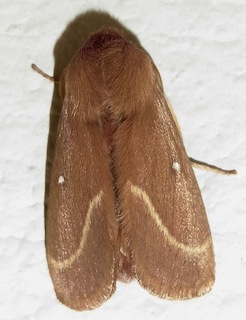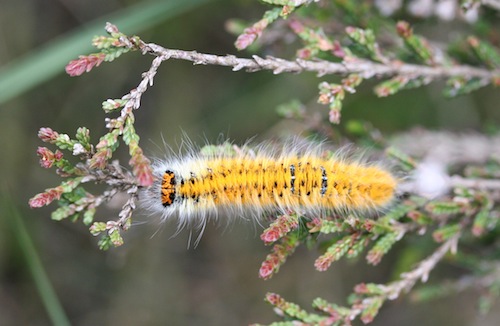 The sea-cliffs of the south-west, including those of The Lizard, are among the best places to find the Grass Eggar moth, a nationally scarce species.
The sea-cliffs of the south-west, including those of The Lizard, are among the best places to find the Grass Eggar moth, a nationally scarce species.
Photo: Wikimedia Commons
Scientific name: Lasiocampa trifolii
Cornish name: ‘Gouwan’ is the general word for moth
Conservation status: Nationally Scarce in the UK
What to look for:
- Colouring: Adult: reddish-brown, curved line crossing the forewing with white spot near centre (see photo of adult female; males are similar, but smaller). Hindwings are plain. Colour does vary geographically, with darker forms occurring further north and west. Caterpillars are yellow and hairy.
- Size: Forewing, 21 to 24 mm (male), 25 to 30 mm (female); caterpillar reaches up to mm in length.
- Where: Sand-dunes, cliffs and coastal shingle in localised areas of the south-west and north-west of the UK. In Cornwall, is mainly on sea-cliffs; it is also found inland on heathland in Dorset.
- When: Nocturnal: adults fly in August and September. Caterpillars feed nocturnally from March to July.
- Similar species: Pale Grass Eggar (rare form of Grass Eggar, restricted to Dungeness in Kent and Channel Islands), Oak Eggar.
 The Grass Eggar is classified as Nationally Scarce in the UK. Although it is found in both the north-west and south-west of the country, its distribution is highly localised. It is more widespread in the Channel Islands.
The Grass Eggar is classified as Nationally Scarce in the UK. Although it is found in both the north-west and south-west of the country, its distribution is highly localised. It is more widespread in the Channel Islands.
Adults are on the wing in high summer, but they are nocturnal so not often seen, although they are attracted to light so may turn up in moth traps. You are more likely to see the hairy yellow caterpillars in the spring and earlier summer, although these also mainly feed by night on a variety of food plants, including grasses.
The adult females scatter their eggs in short vegetation, where they overwinter before hatching the following year. The caterpillars pupate from June/July, emerging as adults in August.
The Grass Eggar is also endangered in parts of Europe. The main threats here and in Europe are fragmentation, agricultural intensification, and loss of the low-level grazing that keeps the sward height lower.
Did you know…?
…Regional cuisine: the preferred larval foodplants vary from place to place, from Creeping Willow in Lancashire to Marram Grass in Dorset. It has also been recorded feeding on Bird’s-foot Trefoil, Thrift and Purple Clover, amongst other things.
More information and references:
Chinery, M., 2005. Collins Complete Guide to British Insects. Collins, London.
Crafer, T., (compiler), 2005. Foodplant List for the Caterpillars of Britain’s Butterflies and Larger Moths. Atropos Publishing, Holmfirth, UK.
Waring, P., Townsend, M. and Lewington, R., 2009. Field Guide to the Moths of Great Britain and Ireland (second edition). British Wildlife Publishing, Gillingham, Dorset.
Published: June 2015
Author: Amanda Scott
Photos:
Adult female: by Donkey shot / CC BY-SA 3.0 via Wikimedia Commons
Caterpillar: Svdmolen assumed (based on copyright claims) / CC BY-SA via Wikimedia Commons

